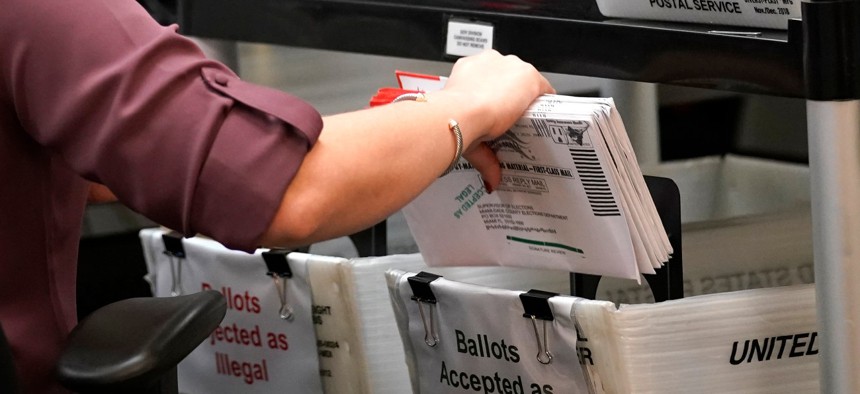
An election worker sorts vote-by-mail ballots at the Miami-Dade County Board of Elections on Oct. 26 in Doral, Fla. Lynne Sladky / AP
USPS Is Again Notifying Employees That DeJoy's Reforms Are Null and Void
Court issues new mandate amid renewed spikes in mail delays.
Following another court order, the U.S. Postal Service is sending out a new round of notifications formally repealing the most significant operational change implemented by its new chief executive.
Postmaster General Louis DeJoy’s initiative to limit late and extra transportation trips within the USPS network has caused severe delays in the mail, which have persisted months after its implementation. A series of injunctions against the Postal Service have already required the mailing agency to walk back those reforms, but an order late Tuesday from a federal judge was the most direct yet requiring management to instruct local leaders those trips must continue as needed to restore on-time performance.
Emmet Sullivan, a judge in the U.S. District Court for the District of Columbia, mandated that postal leadership tell any employee who was previously informed of DeJoy’s push to dramatically scale back late and extra trips that the directive is no longer operative and USPS personnel should perform those trips “to the maximum extent necessary to increase on-time mail deliveries, particularly for election mail.” Sullivan instructed USPS to tell employees specifically that “late and extra trips should be performed to the same or greater degree than they were performed prior to July 2020 when doing so would increase on-time mail deliveries” and that “any prior communication that is inconsistent with this instruction should be disregarded.”
Dave Partenheimer, a USPS spokesman, confirmed the agency will comply with the order, adding USPS takes “all of our legal obligations very seriously.”
DeJoy’s policy emphasized that mail transportation between processing plants and other facilities should operate on a set schedule without costly late or extra trips. While postal officials said it was not their intention, that led to facilities across the country sending out trucks even if most of the mail scheduled to be sent out that day had not yet arrived. Previous court orders instructed USPS to tell employees they should not leave mail behind in order to send trucks out on time.
Late and extra trips have ticked up since DeJoy’s policy went into effect, but still remain far below the levels at which they were used prior to that reform.
While on-time performance increased slightly after the initial court orders went into effect and DeJoy rolled back other initiatives, mail delays are again plaguing the agency. According to data made available to Sullivan’s court as part of a lawsuit brought on by the NAACP, USPS delivered less than 70% of First-Class mail on time on Wednesday. The Postal Service was averaging around 91% on-time delivery in the weeks prior to DeJoy’s policies taking effect. Postal management cautioned in its court filings the daily data may be incomplete and unreliable, saying its weekly information is more accurate. Still, the daily data showed some troubling trends in many regions of the country as voters make a final push to return their mail ballots. In the Philadelphia area, for example, USPS delivered just 42% of First-Class mail on time on Wednesday. In Baltimore, that figure was 39%.
USPS continues to outperform its national numbers with the election mail it is able to track, which the agency has cautioned is not all of it. It delivered 95% of in-bound ballots and 89% of outbound ballots on time on Wednesday. In the week ending Oct. 16, the most recent weekly figures currently available, those rates were 96% for in-bound ballots and 97% for outbound ballots. USPS ramped up the measures it has taken to ensure election mail is delivered in a timely fashion in the final stretch before Election Day on Nov. 3, in part due to a series of court orders requiring the actions. The mailing agency has committed a slew of additional resources specifically aimed at ballots, including increased overtime, additional trips, expediting election mail for delivery and new processes each day to flag the specially marked mail.
Both the daily data and the weekly election mail figures measured the timeliness of processing only within the USPS network rather than delivery to the mail pieces’ final destinations.
On Thursday, USPS will face another court mandate to send a second notice to employees instructing them to liberally use late and extra trips, as well as a list of state-specific ballot delivery deadlines. The plaintiffs and USPS will, starting Wednesday, meet daily with Sullivan to go over operational and performance data.







